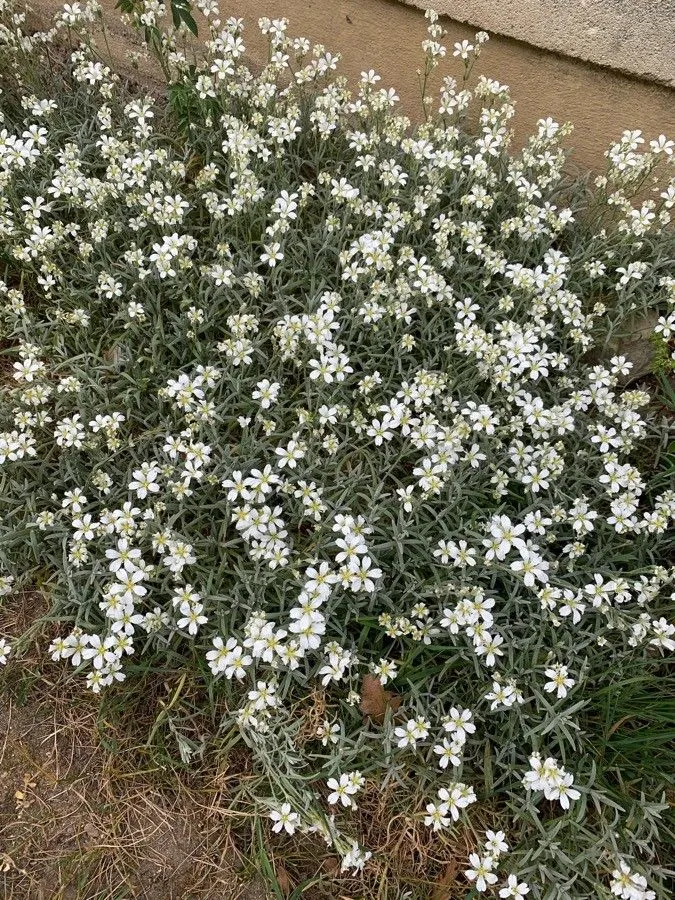
Author: L.
Bibliography: Sp. Pl.: 440 (1753)
Year: 1753
Status: accepted
Rank: species
Genus: Cerastium
Vegetable: False
Observations: Italy (C. & S. Appennini), Corse, Sicilia
Dusty-miller, a perennial plant known for its distinctive silvery foliage, is scientifically recognized as Cerastium tomentosum. This hardy and attractive plant belongs to the Caryophyllaceae family and has been acknowledged in scientific literature since it was first described in “Sp. Pl.: 440 (1753)” by the author L.
Endemic to certain regions, the natural habitat of Dusty-miller spans parts of Italy, including the Central and Southern Apennine regions, extending to Corsica and Sicily. These geographic locations underline the plant’s ability to thrive in Mediterranean climates, characterized by hot, dry summers and mild, wet winters.
Dusty-miller is often appreciated in garden landscapes for its aesthetic appeal. The plant’s foliage is densely covered with fine, white hairs, giving it a felt-like texture and a striking, ghostly silver appearance. This silvery hue not only adds visual interest but also serves a practical purpose, reflecting sunlight and reducing water loss, which is crucial for its survival in arid environments.
In addition to its foliage, Dusty-miller produces charming white flowers, typically blooming in the late spring to summer months. These delicate flowers contrast beautifully with the leaves, providing a subtle yet enchanting display in garden beds, borders, and rock gardens.
The plant’s resilience, low maintenance needs, and tolerance to drought make it a popular choice among gardeners seeking to create visually appealing, low-water landscapes. Moreover, Dusty-miller can be used as a ground cover, helping to suppress weeds while adding a unique textural element to the garden.
In summary, Cerastium tomentosum, or Dusty-miller, is a versatile and striking plant that not only enhances garden aesthetics with its silvery foliage and white blooms but also demonstrates adaptability to challenging growing conditions typical of its native regions in Italy, Corsica, and Sicily.
Eng: dusty-miller, snow in summer, snow-in-harvest, snow-in-summer, snow-on-the-mountain, dusty miller
Dan: filtet hønsetarm, gråbladet hønsetarm
Deu: filziges hornkraut, italien-filz-hornkraut
Fra: céraiste tomenteux, argentine, barbette, oreille de souris
Est: karvane kadakkaer
Hun: molyhos madárhúr
Ces: rožec plstnatý
Swe: silverarv
Nld: viltige hoornbloem
Cym: clust llygoden y felin, clust-y-llygoden y felin
En: Dusty-miller, Snow-in-harvest, Snow-in-summer, Snow-on-the-mountain, Snow in summer, Dusty miller
Af: Somersneeu
Zh: 夏雪草
Cs: Rožec plstnatý
Da: Filtet hønsetarm, Gråbladet hønsetarm
Nl: Viltige hoornbloem
Et: Karvane kadakkaer
Fi: Hopeahärkki
Fr: Céraiste tomenteux, Céraiste cotonneux, Argentine, Barbette, Oreille de souris, Argentine des jardins, Bulette, Myosotis des jardiniers
De: Filziges Hornkraut, Italien-Filz-Hornkraut
Hu: Molyhos madárhúr
Is: Völskueyra
It: Peverina tomentosa
Lt: Gauruotoji glažutė
Pl: Rogownica kutnerowata
Ro: Lâna caprelor
Ru: Ясколка войлочная
Es: Nieve de verano
Sv: Silverarv
Cy: Clust-y-llygoden y felin, Clust Llygoden y Felin
Taken May 14, 2017 by Sarah Dechamps (cc-by-sa)
Taken Jun 12, 2019 by Manu Pacha (cc-by-sa)
Taken Jun 12, 2019 by Manu Pacha (cc-by-sa)
Taken Jun 12, 2019 by Manu Pacha (cc-by-sa)
Taken Jun 12, 2019 by Manu Pacha (cc-by-sa)
Taken Aug 8, 2021 by Pieter Verbrugghe (cc-by-sa)
Taken May 17, 2022 by William Coville (cc-by-sa)
Taken Jun 15, 2021 by Mariusz Staniszewski (cc-by-sa)
Taken Jan 4, 2022 by david Morel (cc-by-sa)
Taken May 14, 2017 by Sarah Dechamps (cc-by-sa)
Taken Apr 22, 2021 by Marieke Wiersma (cc-by-sa)
Taken May 6, 2020 by kon nik (cc-by-sa)
Taken Jun 2, 2019 by Reinhard Röder (cc-by-sa)
Taken Jun 22, 2022 by anna866392 (cc-by-sa)
Taken May 18, 2021 by huy HO (cc-by-sa)
Taken May 8, 2022 by Fabrice Rubio (cc-by-sa)
Taken Jun 23, 2020 by Alain Bigou (cc-by-sa)
Taken Jun 1, 2022 by lyrata glass (cc-by-sa)
Taken May 18, 2016 by Tela Botanica − Laurence MORANDINI (cc-by-sa)
Taken Apr 24, 2020 by maryne sans (cc-by-sa)
Taken Aug 17, 2022 by lg_bc (cc-by-sa)
Taken Jun 11, 2022 by Anatas (cc-by-sa)
Taken Jul 22, 2022 by Tristan Jaton-Maria (cc-by-sa)
Taken Jun 16, 2022 by William Coville (cc-by-sa)
Taken Aug 14, 2021 by Emanuele Santarelli (cc-by-sa)
Taken May 12, 2021 by Laura Gomez (cc-by-sa)
Taken Apr 18, 2020 by Dieter Albrecht (cc-by-sa)
Taken Jun 20, 2019 by philipe Philippe74 (cc-by-sa)
Taken Sep 30, 2020 by Ugne Sliekyte (cc-by-sa)
Taken May 17, 2019 by Daniela Todoran (cc-by-sa)
© copyright of the Board of Trustees of the Royal Botanic Gardens, Kew.
© copyright of the Board of Trustees of the Royal Botanic Gardens, Kew.
© copyright of the Board of Trustees of the Royal Botanic Gardens, Kew.
Family: Myrtaceae Author: (F.Muell.) K.D.Hill & L.A.S.Johnson Bibliography: Telopea 6: 402 (1995) Year: 1995 Status:…
Family: Rubiaceae Author: Pierre ex A.Froehner Bibliography: Notizbl. Bot. Gart. Berlin-Dahlem 1: 237 (1897) Year:…
Family: Sapindaceae Author: Koidz. Bibliography: J. Coll. Sci. Imp. Univ. Tokyo 32(1): 38 (1911) Year:…
Family: Asteraceae Author: A.Gray Bibliography: Pacif. Railr. Rep.: 107 (1857) Year: 1857 Status: accepted Rank:…
Family: Fabaceae Author: Medik. Bibliography: Vorles. Churpfälz. Phys.-Ökon. Ges. 2: 398 (1787) Year: 1787 Status:…
Family: Aspleniaceae Author: (Cav.) Alston Bibliography: Bull. Misc. Inform. Kew 1932: 309 (1932) Year: 1932…